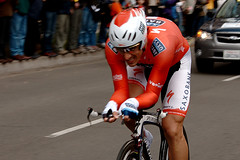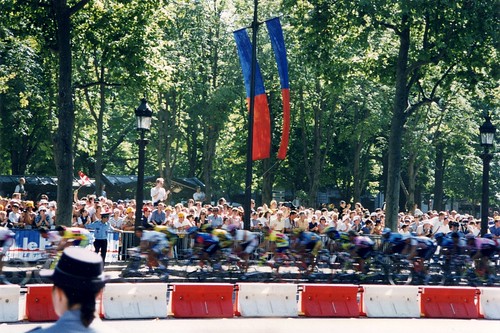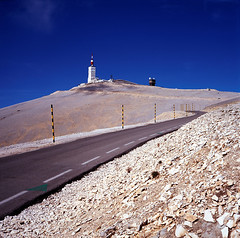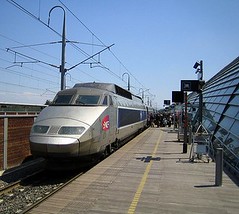Giving new meaning to sports "training"

Posted July 27, 2009 at 1:20PM
Will more sports teams be taking the train to their next event instead of flying?
I'm writing this on my laptop just minutes after watching the Tour de France finish another year in its storied history, with perhaps the most impressive finishing sprint win I've ever seen by the UK's Mark Cavendish. The excitement on l'Avenue des Champs-Elysees (see photo above from a previous year; guess when) concluded the world's best annual sporting event after a mostly ceremonial ride into Paris from the day's start in the town of Montereau-Fault-Yonne, honoring the dominance of this year's overall winner, Alberto Contador, and the ties that bind all fellow competitors in international cycling. Sunday's relatively easy ride (until the end!) followed a brutal climb in Saturday's 20th stage up the legendary Mont Ventoux (photo) in Provence.
The Tour is a three-week event and, most of the time, each new stage begins very close to the previous day's finish, so the logistics are relatively uncomplicated. But, because the final day finishes in Paris, it's not unusual for there to be a considerable distance from whatever part of the country had been hosting the day before. In this case, there were approximately 400 miles between Saturday's finish and Sunday's start.
 Would the athletes fly in chartered planes, as almost all American professional teams do? No way, not in the land of the world's fastest passenger train, the TGV. All they had to do was board the train in Avignon's high-tech station (photo above) and they would be a short bus ride from Sunday's start. (I'm not sure which site hosted the teams' hotels for the night in between, but you get the idea.) The trip on the TGV basically took a couple of hours.
Would the athletes fly in chartered planes, as almost all American professional teams do? No way, not in the land of the world's fastest passenger train, the TGV. All they had to do was board the train in Avignon's high-tech station (photo above) and they would be a short bus ride from Sunday's start. (I'm not sure which site hosted the teams' hotels for the night in between, but you get the idea.) The trip on the TGV basically took a couple of hours.
Now, they weren't doing this to be green. It was simply the most convenient way to go, in a country and on a continent that has always invested in excellent rail infrastructure. Sadly, it's not that way in most of the US, with the notable exception of the Washington-to-Boston corridor and perhaps one or two other places. We may well be on the verge of significant high-speed rail investment here, but we're a long way from that now.
Still, where we do have it, why not use it? Last week, the Saint Louis Cardinals did exactly that, choosing the train to transfer between games in Washington and Philadelphia. This was the first time the Cards have gone by rail in over 40 years, but general manager John Mozeliak told NPR (go here to listen) that many players wanted to do it, and that the train would save the team both time and money.
Timothy B. Hurst, writing on the blog gas2.0, believes the "back to the future" mode of rail travel could become more commonplace in baseball:
"For the many decades before the proliferation of commercial air travel, the preferred (and virtually only) mode of high-speed travel for Major League Baseball teams was the railroad. But in 1934, the Cincinnati Reds flew 19 of their players to Chicago for a series with the Cubs, making the Reds the first team to travel by airplane. A dozen years later the Yankees became the first team to do it on a regular basis.
"Even then, travel by plane for baseball teams was not a common occurrence until the late 1950s when air travel became safer, cheaper and faster. This is also around the time that some East Coast teams began to relocate to California, almost necessitating travel by plane. Since then, teams have rarely looked back to the railroad, preferring to fly even the shortest of distances to away games.
"But now that certain high-speed train routes in the U.S. are quicker and easier than those same routes are via plane, those conventions may be beginning to change, albeit slowly. And with $10 billion in stimulus money flowing to high-speed rail, it is quite possible that more Major League Baseball and other professional sports teams that travel thousands of miles per year will consider taking to the rails for some of their shorter road trips."
Back to the Tour, I'm happy to report that my favorite rider, Swiss champion (and former Olympic and world time-trial champion) Fabian Cancellara, had a terrific race, winning the first stage, wearing the yellow jersey for several days, and escorting two of his teammates to second and fourth place overall. I'm not entirely sure what I will do with myself now that it's over, though, since I've basically been watching two or three hours a day for the last three weeks. Get a life, perhaps? Ride my own bike? Attack my personal Mont Ventoux, something called Tilden Street? Maybe tomorrow.


